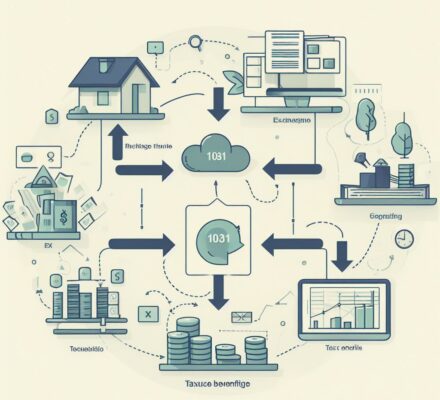Did you know that a 1031 exchange can offer you not just one, but eight amazing tax benefits?
With this powerful tax strategy, you can defer taxes, save on capital gains, and even increase your cash flow.
It provides you with opportunities for property upgrades, diversification, and flexibility in your investment choices.
Plus, it offers estate planning benefits and the potential for long-term wealth accumulation.
Discover the incredible advantages of a 1031 exchange and maximize your financial gains.
Key Takeaways
- Defers taxes on capital gains by reinvesting proceeds into a like-kind replacement property
- Maximizes capital gains savings by deferring payment of taxes through a 1031 exchange
- Maximizes monthly income with increased cash flow through a 1031 exchange
- Diversifies investment portfolio through a 1031 exchange, spreading investments across various asset classes and reducing risk
Tax Deferral
By participating in a 1031 exchange, you can defer taxes on your capital gains by reinvesting the proceeds from the sale of your property into a like-kind replacement property within a specific timeframe. This tax deferral strategy allows you to postpone paying taxes on the gains you have made from the sale of your property, giving you the opportunity to reinvest those funds into a new property and potentially generate more wealth. The 1031 exchange allows you to defer both federal and state taxes, providing you with significant savings in the long run.
To qualify for tax deferral, you must adhere to strict guidelines. Firstly, the replacement property must be of equal or greater value than the relinquished property. Additionally, you must identify the replacement property within 45 days of selling your property and complete the acquisition within 180 days.
Capital Gains Savings
To maximize your capital gains savings through a 1031 exchange, you can take advantage of the tax deferral strategy. This strategy allows you to defer paying capital gains taxes on the sale of an investment property by reinvesting the proceeds into another qualifying property. By deferring the tax, you can keep more of your profits working for you, allowing for greater potential growth and increased investment power.
The key benefit of a 1031 exchange is the ability to defer the payment of capital gains taxes. When you sell a property and realize a capital gain, you’d typically owe taxes on that gain in the year of the sale. However, through a 1031 exchange, you can defer paying those taxes as long as you reinvest the proceeds into a like-kind property within a specific timeframe.
By deferring the tax payment, you can keep the full amount of your capital gains working for you. This allows you to leverage your gains to acquire a larger or more valuable property, potentially increasing your overall return on investment. Additionally, by deferring the tax liability, you have more capital available for reinvestment, giving you greater flexibility and opportunities to diversify your investment portfolio.
Increased Cash Flow
Maximize your monthly income with an increased cash flow when utilizing a 1031 exchange. By taking advantage of this tax-deferred exchange, you can generate more cash flow from your investment properties.
One way to achieve increased cash flow is by exchanging into a property with higher rental income potential. For example, if you currently own a property that generates $2,000 in monthly rent, you can exchange it for another property that has the potential to generate $3,000 in monthly rent. This $1,000 increase in rental income can significantly boost your cash flow.
Another way to enhance cash flow is by exchanging into properties with lower expenses. For instance, if you currently own a property with high maintenance costs, you can exchange it for a property that requires fewer repairs and maintenance. This reduction in expenses will result in a higher net operating income and ultimately increase your monthly cash flow.
Additionally, a 1031 exchange allows you to defer paying capital gains taxes, which can further contribute to your increased cash flow. By deferring these taxes, you have more funds available to allocate towards your monthly income.
Portfolio Diversification
Diversify your portfolio through a 1031 exchange and reap the tax benefits. One of the key advantages of a 1031 exchange is the opportunity it provides for portfolio diversification. By exchanging your property for a different type of property, you can spread your investments across various asset classes and reduce risk.
With a 1031 exchange, you have the flexibility to exchange a residential property for a commercial property or vice versa. This allows you to tap into different markets and industries, potentially increasing the potential for higher returns. Furthermore, you can also diversify geographically by exchanging properties in different locations. This can help protect against the risks associated with local market fluctuations.
Portfolio diversification is a fundamental strategy for mitigating risk and maximizing returns in investment. Through a 1031 exchange, you have the opportunity to strategically allocate your assets across different property types and locations, thus reducing the impact of any one property’s performance on your overall portfolio.
Property Upgrade Opportunities
When considering a 1031 exchange, property upgrade opportunities provide you with the chance to maximize the value of your investment. By strategically upgrading your property, you can increase its appeal and rental income potential, allowing you to generate higher returns in the long run.
Additionally, a 1031 exchange offers tax-deferred exchange options, allowing you to defer capital gains tax and reinvest the proceeds in a new property.
Maximizing Property Value
By taking advantage of property upgrade opportunities, you can significantly enhance the value of your investment through a 1031 exchange. When considering a property upgrade, it’s crucial to focus on enhancements that will attract potential tenants or buyers and increase the property’s overall appeal.
Upgrading the property’s amenities, such as adding a swimming pool or fitness center, can make it more desirable to renters or buyers, thereby increasing its value. Additionally, investing in energy-efficient upgrades, such as solar panels or energy-saving appliances, not only attracts eco-conscious tenants but also reduces operational costs, ultimately boosting the property’s value.
Upgrading the property’s infrastructure, including plumbing, electrical systems, and HVAC, ensures its functionality and longevity, further enhancing its worth. By strategically selecting property upgrades, you can maximize the value of your investment, making it an attractive option for a 1031 exchange.
Tax-Deferred Exchange Options
To enhance the tax benefits of your 1031 exchange, consider exploring various tax-deferred exchange options that involve property upgrade opportunities.
One option is a construction exchange, where you can use the proceeds from the sale of your relinquished property to make improvements on the replacement property. By reinvesting the exchange funds in upgrades, you can increase the value of the property and potentially qualify for a larger tax deduction.
Another option is a reverse exchange, which allows you to acquire the replacement property before selling your relinquished property. This option is beneficial when there’s a limited supply of replacement properties or when timing is critical.
Additionally, a build-to-suit exchange allows you to construct a replacement property that meets your specific needs.
These tax-deferred exchange options provide flexibility and opportunities for property improvement, allowing you to maximize the tax benefits of your 1031 exchange.
Flexibility in Investment Choices
One of the best tax benefits of a 1031 exchange is the flexibility it offers in expanding your investment choices. This powerful tool allows you to sell an investment property and reinvest the proceeds into a like-kind property, all while deferring the payment of capital gains taxes. By utilizing a 1031 exchange, you have the flexibility to diversify your investment portfolio and explore new opportunities in different markets and asset classes.
With a 1031 exchange, you can exchange a property in one location for another property in a completely different location. For example, you can sell a residential property in a bustling urban area and acquire a commercial property in a suburban neighborhood. This flexibility allows you to adapt to changing market conditions and capitalize on emerging trends.
Furthermore, a 1031 exchange enables you to upgrade or downgrade your property. If you have outgrown your current property or if you prefer a smaller investment, you can exchange your existing property for a larger or smaller one, respectively. This flexibility allows you to align your investment portfolio with your changing financial goals and objectives.
In addition, a 1031 exchange offers the opportunity to consolidate multiple properties into a single property. This consolidation can streamline your investment portfolio, reduce management responsibilities, and potentially increase your cash flow.
The flexibility provided by a 1031 exchange isn’t only beneficial for optimizing your investment choices, but it also offers significant estate planning benefits. By deferring capital gains taxes, you can preserve your wealth and potentially pass it on to future generations. This will be discussed in more detail in the subsequent section on estate planning benefits.
Estate Planning Benefits
When considering estate planning benefits of a 1031 exchange, there are several key points to keep in mind.
First, implementing tax savings strategies is crucial in order to minimize your tax liability and maximize your wealth preservation.
Additionally, a 1031 exchange can help you minimize estate tax liability by allowing you to defer taxes on the appreciation of your investment properties.
Tax Savings Strategies
Maximize your tax savings by utilizing efficient estate planning strategies. Here are four tax-saving strategies that can help you optimize your estate planning:
- Gifting: One effective strategy is to gift assets during your lifetime, reducing the size of your taxable estate. By gifting assets to your heirs, you can take advantage of the annual gift tax exclusion and potentially lower your overall estate tax liability.
- Charitable Trusts: Establishing charitable remainder trusts or charitable lead trusts can provide both estate tax and income tax benefits. These trusts allow you to donate assets to a charitable organization while retaining certain income rights or providing income to beneficiaries for a specified period.
- Family Limited Partnerships: Creating a family limited partnership allows you to transfer assets to the partnership and retain control over the assets while reducing your estate tax liability. This strategy can also provide additional asset protection benefits.
- Generation-Skipping Transfer Tax: Utilizing generation-skipping transfer tax exemptions can allow you to transfer assets directly to grandchildren or future generations, bypassing estate taxes that would be incurred if the assets were passed down through your children.
By implementing these tax-saving strategies, you can’t only minimize estate taxes but also ensure the preservation of your wealth for future generations.
Now let’s delve into the next section, which focuses on long-term wealth preservation.
Long-Term Wealth Preservation
To ensure long-term wealth preservation through estate planning benefits, consider utilizing a 1031 exchange for tax advantages.
A 1031 exchange allows you to defer capital gains taxes on the sale of an investment property by reinvesting the proceeds into a like-kind property. By deferring taxes, you can preserve your wealth and have more capital available for future investments.
This strategy is particularly beneficial for individuals looking to pass on their wealth to future generations. By utilizing a 1031 exchange, you can defer taxes and potentially increase the value of your estate over time. This can provide your heirs with a larger inheritance and help you establish a lasting legacy.
To further enhance your estate planning, it’s essential to also consider minimizing estate tax liability, which will be discussed in the next section.
Minimizing Estate Tax Liability
To ensure effective estate planning benefits and minimize estate tax liability, consider utilizing a 1031 exchange for long-term wealth preservation. Here are four ways a 1031 exchange can help you minimize estate tax liability:
- Deferral of capital gains taxes: By exchanging your investment property for a like-kind property, you can defer paying capital gains taxes. This allows you to keep more of your wealth invested and working for you.
- Step-up in basis: When you pass away, your heirs receive a stepped-up basis on the property. This means they inherit the property at its current fair market value, potentially reducing the capital gains taxes they’d have to pay if they were to sell it.
- Estate tax exclusion: The value of the property held in a 1031 exchange is generally excluded from your taxable estate. This can help reduce your estate tax liability and preserve more wealth for future generations.
- Flexibility in estate planning: With a 1031 exchange, you have the flexibility to reposition your real estate holdings to meet your changing estate planning goals and objectives.
Long-Term Wealth Accumulation
Build your wealth over time with the long-term benefits of a 1031 exchange. This powerful tax strategy allows you to defer capital gains taxes on the sale of investment properties, giving you the opportunity to reinvest your profits and continue to grow your portfolio. By exchanging your property for another like-kind property, you can defer paying taxes on any gains made from the sale, allowing you to keep more money in your pocket to reinvest.
One of the key advantages of a 1031 exchange is the ability to compound your wealth over time. Instead of paying taxes on your gains, you can use those funds to acquire a larger and more valuable property. This allows you to take advantage of appreciation and the potential for increased rental income. By continually exchanging properties, you can leverage the power of compounding to accelerate your wealth accumulation.
Additionally, a 1031 exchange provides you with flexibility and control over your investment strategy. You can strategically diversify your portfolio by exchanging into different types of properties or investing in different markets. This allows you to adapt to changing market conditions and take advantage of emerging opportunities.
Frequently Asked Questions
Are There Any Time Limitations or Deadlines Involved in Completing a 1031 Exchange?
There are time limitations and deadlines involved in completing a 1031 exchange. It is important to complete the exchange within 180 days and identify replacement properties within 45 days.
Can I Use a 1031 Exchange to Defer Taxes on the Sale of a Second Home or Vacation Property?
Yes, you can use a 1031 exchange to defer taxes on the sale of a second home or vacation property. This allows you to reinvest the proceeds into a like-kind property and defer capital gains taxes.
Is There a Limit to the Number of Times I Can Use a 1031 Exchange to Defer Taxes on Real Estate Investments?
There is no limit to the number of times you can use a 1031 exchange to defer taxes on real estate investments. This allows you to continuously reinvest your capital gains and defer taxes indefinitely.
Can I Exchange a Property for Multiple Properties in a 1031 Exchange?
Yes, you can exchange a property for multiple properties in a 1031 exchange. For example, if you sell a commercial building, you can use the proceeds to purchase several rental properties.
How Does a 1031 Exchange Affect the Basis of the New Property Acquired?
When you participate in a 1031 exchange, the basis of the new property acquired is determined by the adjusted basis of the property you relinquished, plus any additional funds invested.




